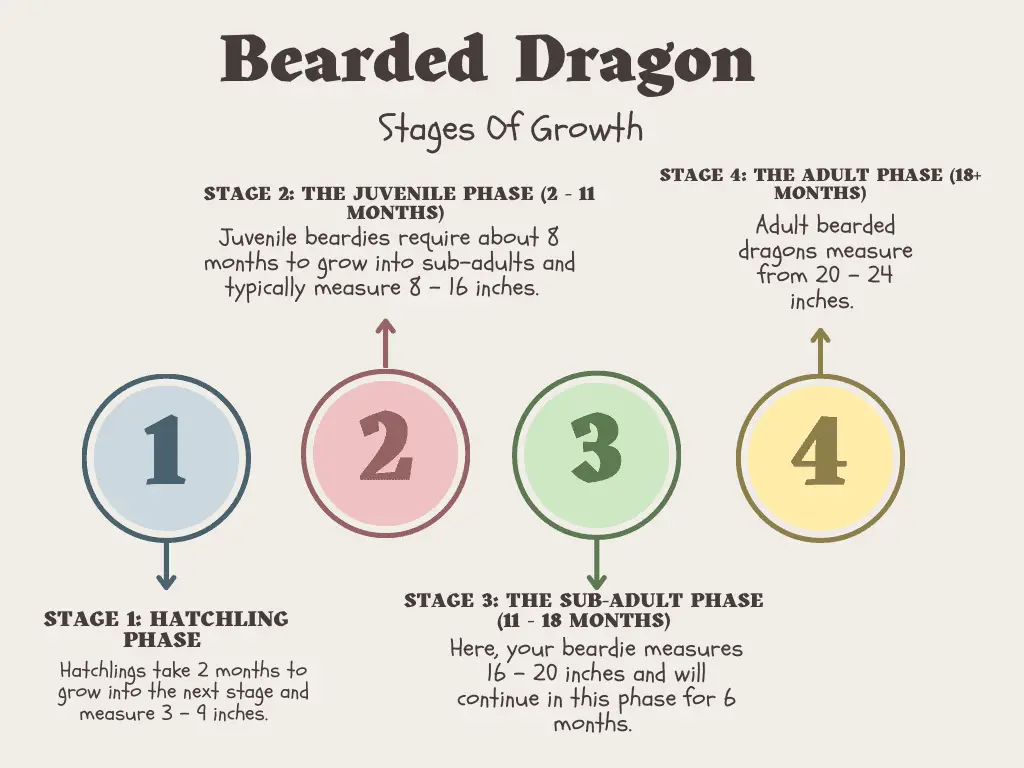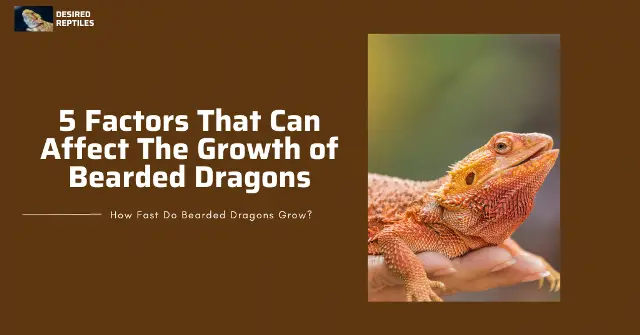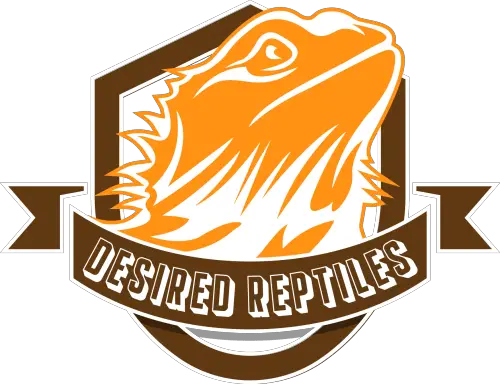If you have recently adopted a young bearded dragon, you’d likely wonder how long it takes for it to reach adulthood especially when you’re faced with the hurdle of handling hatchlings. Young bearded dragons need to be fed more frequently and require more attention than adults, which may be overwhelming for new owners.
I found it pretty challenging to handle my first set of hatchlings and kept wishing they’d hurriedly grow into adults. My desperation only worsened with every time I had to frequently clean piles of smelly poop! If this is your experience, or if you’re simply curious about the lifecycle of bearded dragons, this article will provide the answers you need regarding the duration it takes them to grow.
The transition from a hatchling to an adult bearded dragon takes about 18 months. During this period, beardies go through four distinct stages – baby, juvenile, sub-adult, and adult – all of which take different amounts of time to complete.
The Life Cycle And Growth Duration Of Your Bearded Dragon
Bearded dragons progress through distinct stages with varying timelines to reach adulthood. To know how long it will take for your beardie to grow, you must understand the different phases and pinpoint your pet’s current position in the process.
Stage 1: Hatchling Phase (0 – 2 months)
Upon hatching, baby bearded dragons are as tiny as three inches, small enough to fit snugly in the palm of your hand. During the hatchling stage, they eat voraciously, requiring a diet high in protein, around 70%, to fuel their rapid growth and development. This is also the most active period, as they metabolize food much faster to build substantial muscle mass.
Did you know that bearded dragons have evolved to rapidly grow out of the hatchling phase? Since they are prey to many predators in the wild, it’s necessary to quickly progress through the vulnerable baby stage to avoid becoming easy targets for large birds or wild rodents. In just 2 months, baby beardies can increase in size by 9 inches, transitioning to the juvenile stage to continue their lifecycle.
Stage 2: The Juvenile Phase (2 – 11 months)
Juvenile beardies maintain a similar diet to hatchlings but have a slower metabolism in comparison. The transition from juvenile to the sub-adult phase takes considerably longer, lasting around 8 months, in contrast to the 2-month growth period from hatchling to juvenile. During this time, the juvenile dragons, now ranging from 11 to 16 inches in length, steadily increase in size, developing into sub-adults.
Stage 3: The Sub-Adult Phase (11 – 18 months)
At this point, your beardie is welcoming adulthood and the docility that comes with it. The sub-adult dragons break down food much slower than juveniles and hatchlings and require less amount of food such as protein in a day. No more eating heavy protein diets or jumping off your hands when you hold them loosely!
This phase takes 6 months to transition into the fully-grown adult stage and increases your pet’s body length by 2 to 4 inches making it roughly 18 to 20 inches at maximum.
Stage 4: The Adult Phase (18+ months)
Adulthood for bearded dragons entails sexual maturity and easier manageability. After the pre-adult phase, metabolism slows down even more leading to a reduced necessity for a highly protein-rich diet and an increased need for vegetables and minerals.
By two months into adulthood, your beardie is fully mature, ranging from 20 to 24 inches, and is ready for breeding, starting a new cycle of bearded dragons from eggs to hatchlings to adult beardies.

How To Track Your Bearded Dragon’s Growth And Tell Its Age
If you are wondering what stage your beardie is in, there are a few ways you can tell. It requires tracking and measuring your beardie every month to note the increase in length.
By using the table below, you can determine the current phase or stage of your beardie.
| Age | Length In Inches |
|---|---|
| 0 – 1 month | 3” – 5” |
| 2 months | 5” – 9” |
| 3 months | 8” – 11” |
| 4 months | 9” – 11” |
| 5 months | 11” – 16” |
| 6 months | 12” – 18” |
| 8 months | 13” – 20” |
| 12 – 18 months | 16” – 24” |
To apply these values in the table above, here are the stages with the length associated with them:
- Baby Beardies: 3 to 9 inches in 2 months.
- Juvenile Beardies: 8 to 16 inches in 8 months.
- Sub-adult Beardies: 16 to 20 inches in 6 months.
- Adult beardies: 20 to 24 inches in 2 months.

5 Factors That Affect The Growth Rate Of Bearded Dragons
Bearded dragons will grow to the adult stage despite any difficulty they face. However, they may easily be stunted or malnourished due to several issues. Here are certain factors that can affect the growth of your bearded dragon:
1. A Poor Diet
A good diet consists of the right ratio of vegetables and protein relative to the age of the beardie. Providing your bearded dragon with an inconsistent or incomplete diet could cause it to grow at a much slower rate or build feeble muscles in comparison to a healthy dragon.
Remember, baby and juvenile beardies require a diet of 70% of protein and 30% veggies, and a frequency of three times a day. A sub-adult beardie should be fed twice a day with 60% protein and 40%l veggies, while a fully-grown adult dragon needs an inverse of the baby dragon’s diet; 30% protein and 70% veggies fed once a day at most.
Examples of good protein choices are:
- Dubia roaches
- Mealworms
- Superworms
- Hornworms
- Crickets
Examples of good vegetable choices are:
- Butternut squash
- Celery
- Collard greens
- Dandelion greens
- Carrots
2. Difference In Genetics
Genetics greatly affects the growth and appearance of bearded dragons. There are 8 recognized species of bearded dragons, however, only two are commonly kept as pets – the central bearded dragon and the eastern bearded dragon.
These two species have different genes that impact how they grow. Central bearded dragons tend to be a bit plumper and rounder, while eastern bearded dragons are generally slimmer and longer by a few inches.
Understanding the natural variations between the species is important, so that you do not make inaccurate comparisons between them and draw incorrect conclusions about their growth or development. Knowing the specific species of your pet bearded dragon is key to caring for it appropriately. If you’re unsure about your dragon’s niche species, consider comparing it to photos or videos of eastern or central dragons on the internet and consulting with breeders for clarity.
3. Stress
Stress is a common factor that negatively affects the growth of bearded dragons even more than you may think. A lot of problems can arise from stress; your beardie may refuse to eat or hydrate itself and become dehydrated or become less active leading to decreased access to UVB rays or shade. This could disrupt brumation, and create an avenue for bone diseases to settle in.
When your dragon is stressed, it may alert you by waving, pacing around, hiding away for most of the time, losing appetite, getting agitated and unfriendly toward you or other people, scratching at the tank in an attempt to get out, or overall looking pale, slow, and droopy.
If your pet seems stressed, make sure its environment is calm and quiet. Bearded dragons use noise and vibration to detect danger. So, imagine how your beardie must feel if it thinks the loud hum of appliances around it is a threat, but it can’t escape since it’s in an enclosure! Loud conversations around or having the tank near a window can also stress your pet. Rectifying these problems will help your bearded dragon relax and develop in a healthy, happy way.
4. Presence Of Parasites
The presence of parasites is a gateway to declining health and a slower growth rate. They eat away all the nutrients your beardie consumes for itself and thus, starve your pet of the proper nutrition that is detrimental to its growth. If your dragon is losing appetite, having unusual stools, or looks pale and lean, ensure you visit the vet to check its gut health and ensure it’s free of parasites.
5. Improper Lighting Or Temperature
Your bearded dragon’s enclosure must include all the necessary features for its healthy growth. Lighting and temperature are two major factors that can drastically impact your pet’s health.
Bearded dragons require UVB light to provide them with vitamin D, which is essential for developing strong bones. The correct temperature range is also crucial; your pet needs a basking spot that is 104°F to 107°F, and a cooler shaded area that is 71°F to 77°F.
This temperature gradient allows it to thermoregulate and develop properly. Maintaining the proper lighting and temperature parameters within the enclosure is vital for your bearded dragon’s overall health and maximum growth potential.
Tips That Improve The Growth Of Your Beardie
If your beardie needs a gentle boost to improve its growth and overall well-being, here are some things you can implement to ensure that:
Provide Dietary Routines
Beardies in captivity enjoy routines. As unaware as they seem, they understand when it’s time for food and may even throw a fit if you’re a little late! Invest in providing the correct diet appropriate for your dragon’s age at specific times of the day so that it is conditioned to this routine. It will improve the awareness your pet has of its surroundings and stimulate its brain which will help it thrive.
Invest In Supplements
While dragons in the wild do not need supplements to flourish, your beardie might just require an extra push to grow healthier and more robustly. Calcium and Vitamin D3 (view on Amazon) provide your beardie with an avenue for stronger bones and multivitamins (view on Amazon) ensure that it has a good appetite and gut health to protect it against illnesses.
Encourage Physical Therapy And Bonding
Bearded dragons are fairly sociable pets that like to be held and petted once in a while. Creating a bond between you and your pet will help decrease its stress and acclimate it to its surroundings. It also improves mental activity which has been linked to enhanced metabolism. So, play with your pet more– they certainly want you to!
The Conclusion
As we have discussed, the growth rate of bearded dragons depends on the stage they currently represent in their cycle. Baby beardies have the fastest growth rate and juveniles the slowest, where the sub-adult and adult phases are relatively contained to fit within the process.
After this article, you should be able to determine the age of your beardie as well as monitor its progress and figure out if it is healthy or not. This discussion also equips you with the factors that determine healthy beardie living to help you understand and improve its growth. I wish you and your pet bearded dragon the healthiest life there is. Good luck!
